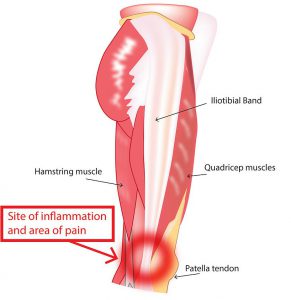Why Frictioning a Tight IT Band is Fruitless
Ever had a nagging pain on the side of your knee while running, especially going downhill? Running requires heavy repetitive flexion and extension of the knee, which can lead to a common overuse injury known as Iliotibial Band Friction Syndrome (ITBFS).
A 2007 anatomy study by Fairclough et al. published in the Journal of Anatomy proves that the iliotibial band (ITB) isn’t just an independent structure on the lateral thigh that moves back and forth the lateral epicondyle of the knee.
As it turns out, the ITB is both fibrously anchored to the femur (thigh bone), and deeply ingrained in the fasciae latae and no, that is not a new Starbucks beverage.
The Fasciae latae is a fascial sleeve that encases the entire thigh much like the casing of sausage, and the notion of the ITB moving back and forth across the lateral epicondyle is not possible because it would require that the entire fasciae latae move as well.

So what is causing the pain? Taking a look closer at the anatomy and mechanics of the knee, it would appear that in flexion and extension, the IT band is blipping over the epicondyle.
In fact, there is a layer of highly vascular fatty tissue and loose connective tissue that separates the ITB from the femur where it attaches at the lateral epicondyle.
When the knee flexes, the pressure of the ITB pulling tight against the fatty tissue is what causes the pain in the ITB friction syndrome.
With this new understanding of the anatomy and biomechanics of the ITB, a deep transverse friction massage applied to the ITB where it attaches on the lateral epicondyle may not be the best way to break up the adhesions and sore spots.
As a matter of fact, any efforts at making a dent in this extremely tough tendinous ligament such as the ITB would be fruitless, according to Erik Dalton, Developer of Myoskeletal Alignment Techniques, “The iliotibial tract is a massive structure made of a substance with greater tensile strength than steel cable. It simply cannot be significantly elongated by rubbing, elbowing or stretching it.”
Fairclough theorized that the ITBFS is connected to the impaired function of the hip, leg and foot, and these areas must be addressed and balanced out for an effective resolution.
That said, Dalton suggests loosening up the tight muscles around the lateral knee such as the vastus lateralis and biceps femoris. These two muscles flank the mighty ITB- The vastus lateralis muscle, the most lateral quadriceps muscle, and the biceps femoris, the most lateral hamstring muscle.
“Tension on the ITB is generated primarily from the TFL and gluteus maximus muscles (see image above), which insert into the band,” notes Whitney Lowe, owner of the Orthopedic Massage and Research Institute (OMERI). In order to resolve this pain syndrome, Lowe suggests reducing tension in these muscles, as well as taking a closer look at the biomechanical imbalances of the lower extremities.
Despite the IT Band being tough as a steel cable, using an active isolated stretch can lengthen it and not cause any harm. Click here to see how.
Getting a Sports Massage can speed up the recovery of an IT Band injury and help prevent it from getting re-injured.

